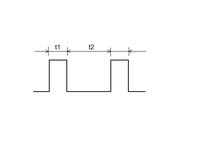tinto
Junior Member level 2

- Joined
- Mar 23, 2011
- Messages
- 21
- Helped
- 0
- Reputation
- 0
- Reaction score
- 0
- Trophy points
- 1,281
- Location
- Kerala, India
- Activity points
- 1,413
what should be the minimum delay between two successive pulses given to a servo motor? Or, what should be the maximum duty cycle of the pulse train given to a servo motor, if the required pulse width to bring the servo motor to middle position is 1.5ms?




